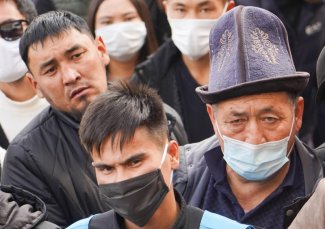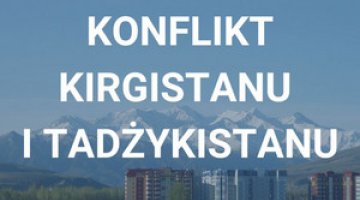Kyrgyzstan in the aftermath of revolution

On 15 October Kyrgyzstan’s president, Sooronobay Jeenbekov, resigned from his position and his duties were taken over by the opposition leader, Sadyr Japarov. The change in power was brought about by large-scale protests which broke out on 5 October, the day after the election; subsequently the protesters took over the main buildings of the central administration in Bishkek and released opposition leaders who had been imprisoned (among them Japarov). The demonstrations, which were forceful but not long-lasting, resulted in a compromise of sorts which led to changes in the highest state positions, the announcement of an early presidential election and a rerun of the parliamentary election.
Despite the situation in the country (particularly in the capital) having been restored to one of relative stability, Kyrgyzstan is still struggling with grave problems: a crisis of the political system, social tensions and a dismal economic situation that is further exacerbated by the implications of the COVID-19 pandemic. The current state of affairs presents a serious challenge both for Russia and China, whose respective interests have an important impact on the politics of Kyrgyzstan and the entire region of Central Asia.
The October Revolution
The Revolution of 5 October is the third such event in Kyrgyzstan’s recent history (the previous ones took place in 2005 and 2010). As in the previous cases, the revolution was the result of a combination of overlapping problems at several levels: opposition to the centralisation of power in the hands of the president and his circles and the fixing of elections, in addition to tensions between different groups of interests, usually with regional and tribal links (following the basic division of the country into the North and the South), that faced accusations of being implicated in organised crime. Traditionally, the main political forces try to play off the international actors present in Kyrgyzstan (Russia and China which replaced the US at least a decade ago) against each other. Consecutive political crises, stimulated by social and economic issues, have weakened the constitutional and legal orders of the country while also acting as a spark for igniting local social tensions (an extreme example of this being the pogroms against the Uzbek minority in the south of the country in 2010). On the other hand, these recurrent crises bear witness to the existence of a pluralist political culture within Kyrgyzstan, whose society possesses informal but effective mechanisms of self-regulation.
This last violent change of power is a manifestation of the willingness of the elites from the North to stop the authoritarian ambitions of President Jeenbekov with the use of social protests. Japarov, who has suddenly emerged as the opposition leader, is a politician with strongly nationalist (also anti-Uzbek) and populist views (for example, he called for foreign investments to be nationalised). He has been active in politics both at the regional and central levels. Japarov has faced accusations of having ties with criminal social networks, and when the revolution erupted he was serving a sentence of over 11 years of imprisonment for abducting a representative of the local government and holding him hostage. Japarov came to power thanks to huge pressure from the protesters and President Jeenbekov’s compromise-based approach to solving the crisis (he declared he was willing to share power and rerun the election, then he withdrew from the race following a unilateral correction of the terms and conditions of the agreement) – bypassing the normal constitutional procedures.
Japarov assumed the position of prime minister and then became acting president of the country, thus consolidating full executive powers in his hands. Following the announcements made, the present parliament is still operating. A constitutional referendum has been scheduled for 11 December and an early presidential election is planned for 10 January 2021.
The new power and new challenges
The present normalisation of the situation (in particular in the capital), the effective handover of power and the outlining of a road map for its legalisation are Japarov’s first and fundamental successes. A surprisingly reformatory and conciliatory tone to the declarations regarding his political manifesto represents the second step towards the stabilization, since the manifesto addresses the concerns expressed by minorities (primarily the Uzbek minority) and includes an announcement of decisive measures to be taken to combat corruption and organised crime (almost immediately, some extraordinary arrests of several high-profile individuals were carried out). The fact that Japarov recognised the present parliament (established following the election that ignited the protests) and the majority of the ministers, and that he also made several appointments to ministerial positions from outside his inner circle, indicates an approach aimed at preserving the current situation. One such example was the appointment of Japarov’s political partner from the South, Kamchybek Tashiev, as the head of the State Committee for National Security.
Irrespective of the new government’s declarations and the implications of the measures undertaken for its image, the question about their genuine impact remains an open one. It will be extremely difficult for Japarov himself to prove that he is capable of guaranteeing the legal order in the country and can rid himself of the charges of being tied to organised crime. He faces similar problems with the concerns of minorities (mainly the Uzbek minority), since both Japarov and the new head of the special services, Tashiev, have been directly accused of being co-responsible for the pogroms of the Uzbek minority in 2020 (the verdicts on these cases affected few of the people directly involved in the pogroms).
However, at the deepest level, the most serious challenges the new government is confronted with are systemic social and economic issues, at present exacerbated by the upheaval following the present revolution, among them the implications of the COVID-19 pandemic and the substantial consequences of the breakdown of mass-scale financial migrations to Russia. It is estimated that approximately 200,000 Kyrgyz labour migrants have been forced to return home from Russia, and that they were in great part the driving force behind the recent events and remain a potential source of further social tensions.
The international dimension
The victorious revolution, as was the case for the previous ones, presents a serious challenge to regional politics. Above all, the regularity and effectiveness of such events in Kyrgyzstan contradicts the authoritarian models followed in Central Asia and also implemented by Russia and China. The Kyrgyz protests constitute a dangerous precedent in the context of social tensions in neighbouring states, and the volatility of Kyrgyzstan’s legal order presents a threat to external investments and interests, ranging from gold mines controlled by Canadian capital (which Japarov once wished to nationalise) to Chinese investments. The final challenge (but not the least important) arises from the growing likelihood of an eruption of nationalist sentiments in Kyrgyzstan; in the past these mostly affected minorities, particularly the Uzbeks constituent, but also the Dungans, Russians, Kurds and other. They also manifest themselves in border disputes with Tajikistan (there are regular border incidents which involve law enforcement officers from both countries and result in casualties on both sides).
All these social tensions present a fundamental challenge to Russia, which treats Kyrgyzstan as being within its sphere of political influence and responsibility, and this approach is generally accepted both in Kyrgyzstan and Central Asia, as well as in China.
On the one hand, Russia’s relative passivity and limited agency (compounded by the current limited capacity to influence Bishkek by regulating labour migrations) in this type of political crises undermine its authority. On the other hand, they are even more acute for China, which has a decidedly weaker impact on political and security issues in Kyrgyzstan than Russia.
The outlook
It should be expected that Japarov will ensure a relative stabilisation of the situation in the country and will effectively legalise his power, since he has shown himself to be fairly competent at handling the situation to date. Among the measures undertaken, he announced that he would resign in order to legally stand in the presidential election in January 2021. However, it remains disputable to what extent his reforms have genuine impact and whether democratisation can be sustained, particularly in the face of the informal societal structures which he makes use of and the various charges linking him to the criminal underworld. It is difficult to gauge how the situation will further unfold in the uncertain, poor and densely populated south of the country, where influential clans of Jeenbekovs and Matraimovs and the Uzbek minority still play important roles.
Kyrgyzstan remains part of Russia’s sphere of influence and its new government is conspicuously seeking to obtain support from this side. However, Russia has increasingly serious problems with effectively managing crises on the peripheries of the former Soviet Union, as is also exemplified – apart from the ongoing crisis in Kyrgyzstan – by the current tensions in Belarus and Nagorno-Karabakh. Kyrgyzstan’s chronic instability and the fact that the country has a border with China’s fragile autonomous region of Xinjiang may eventually lead to China’s active involvement in its neighbour’s problems.


